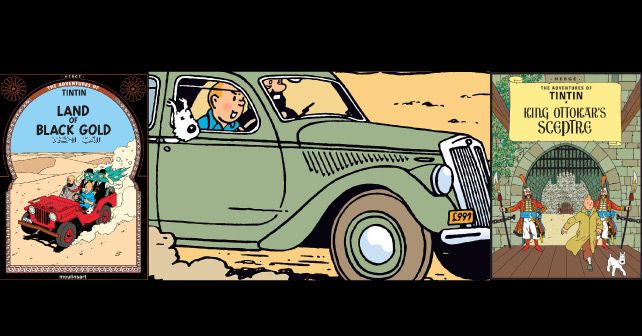
Hergé was a creative giant who was passionate about automobiles, which is why Tintin comics are a treat for car buffs too.
It’s fun to spot the late Stan Lee in the movies that his Marvel superheroes starred in. As Peter Parker’s bus driver in Avengers: Infinity War or a gambler at a casino in Black Panther, Lee’s cameo appearances add tiny, but interesting, diversions. Much before Stan Lee, Hergé – the father of Tintin – too made cameo appearances in a few of the 24 Tintin adventures. Georges Remi, who cleverly twisted his initials to give himself the pen-name of Hergé, however, is significantly more discreet than the creator of Iron Man, Spider-Man and Thor – and his appearances are difficult to spot.
Hard-core Tintin buffs like me take pleasure not only in seeking out Hergé in the panels, but his collaborators and fellow artists as well. As for hardcore Tintin fans who are also classic car buffs (like me, again), there’s an exceptional treat in store in that 1958 adventure, The Red Sea Sharks. Its very last panel is a terrific visual quiz for classic car aficionados. The highly annoying insurance salesman Jolyon Wagg, as president of the Vagabond Car Club, has taken over the beautifully appointed grounds of Marlinspike Hall for the final trials of a rally and 20 iconic cars feature in there. In the comic, the drivers and the cars have created an unholy mess, and this was a scene right out of Hergé’s life. That’s because, being a celebrity in his native Belgium, Hergé’s country house was inevitably a stopover along the routes organised during the car rally season in the summers.
A discreetly parked pale blue 1950s Porsche 356 A is one of the 20 cars in this frame. What makes it special is that it’s one of three cars owned by Hergé that makes its own cameo in the Tintin adventures! Hergé’s two other cars also have their own walk-on parts – an Opel Olympia (a 1935 cabriolet makes an appearance in King Ottokar’s Sceptre) and a 1947 Lancia Aprilia (seen in Land Of Black Gold).
Reading through the adventures, Hergé seems to have been partial to Italian cars – their combination of evocative design and exhilarating performance have perhaps made him a fan. There is a photo of Hergé taken sometime in the early 1960s in front of his above-mentioned country house, fiddling under the front-hinged bonnet of a white Alfa Romeo Giuletta Sprint Veloce and giving a toothy grin to the camera. Yet his renderings of American cars are exceptional, especially when in action. A toothy 1949 Buick Roadmaster literally flies on desert sands in Land Of Black Gold, while King Muskar XII nearly runs over Tintin in his exquisite molten black 1939 Packard Super Eight Coupe in King Ottokar’s Sceptre. And Captain Haddock also has a taste for American iron. He drives around in an unusually flamboyant yellow 1939 Lincoln Zephyr Cabriolet in The Seven Crystal Balls.
Being highly imaginative, Hergé also created his own automobiles based on real ones to go with the situation, or the location of the adventures. For example, a stretch black limousine driven in a convoy in Tapiocapolis features in Tintin And The Picaros. It seems to be the result of a torrid love affair between a long wheelbase Mercedes-Benz 600 and a Soviet ZIL 114 and looks every inch a car that 1970s dictators would love to be seen in. Similarly, an open-topped roadster used to rescue Professor Calculus from the prison fortress of Bakhine in Borduria in The Calculus Affair is a combination of a Facel Vega and a Chevrolet Bel Air, with some bits of a Mercedes-Benz 300 SL thrown in. Of course, the car wears a moustache, which is the national symbol of Borduria, inspired by the whiskers of its leader Marshal Kurvi Tasch.
Most of the time Hergé relied on pictures and press cuttings to illustrate his adventures. He had an immense archive of visual material, which he and his team collated and classified to be used as inspiration for the illustrations. Other than cars, his passion for accuracy is seen in the illustrations of aircraft, trains, ships and boats, architecture, clothes, interiors… well, everything. As you’re reading this, preparations must be going on for the annual Tintin classic car rally in Brussels during the Comic Strip Festival. If you do plan to go there sometime, why don’t you revisit Tintin comics and do some car-spotting in the meanwhile? I assure you, it’s more absorbing, entertaining and enlightening than those Marvel movies.
Also read - Tintin comics feature some amazing cars
We are uniformly 'uncivilised' on our roads
Srinivas Krishnan writes about classic and vintage cars for various publications. He is the former Editor of Business Standard Motoring & former Head of Press, Porsche India.





















Write your Comment